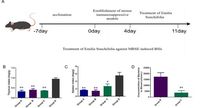In the battle against antibiotic resistance, researchers are turning to traditional plants for potential solutions. Recent findings indicate that the plant Emilia sonchifolia may offer a new weapon against Methicillin-resistant Staphylococcus epidermidis (MRSE), a significant pathogen involved in bloodstream infections (BSIs). This study, published in Scientific Reports, reveals E. sonchifolia's impressive antibacterial effects against MRSE, suggesting a promising avenue for treatment in an era when conventional antibiotics are increasingly ineffective.
BSIs pose a considerable public health challenge, responsible for high morbidity and mortality rates globally. Among the pathogens responsible for these infections, MRSE has emerged as a formidable foe due to its resistance to standard antibiotic therapies. As antibiotic resistance becomes a pressing health concern, traditional Chinese medicine, specifically E. sonchifolia, has garnered interest for its potential antimicrobial properties.
The study assessed the efficacy of E. sonchifolia, using both in vitro and in vivo methods. The researchers determined the minimum inhibitory concentration (MIC) and minimum bactericidal concentration (MBC) of E. sonchifolia against MRSE, finding the MIC to be 5 mg/mL and the MBC at 20 mg/mL. These results indicate that E. sonchifolia is highly effective in inhibiting MRSE growth.
In vivo analysis involved a mouse model of MRSE-induced BSIs. After administration of E. sonchifolia to immunocompromised mice, results showed a significant reduction in bacterial load in the bloodstream, emphasizing the extract's therapeutic potential against infections caused by MRSE. The treatment led to a remarkable decrease in the number of bacteria, indicating that E. sonchifolia effectively combats MRSE-induced infections.
Proteomic and transcriptomic analyses were conducted to understand how E. sonchifolia exerts its antibacterial effects. The results indicated a considerable down-regulation of purine metabolism pathways, which are crucial for bacterial survival. Enzymatic assays revealed that the levels of inosine monophosphate (IMP), adenosine monophosphate (AMP), and guanosine monophosphate (GMP) were inhibited, confirming the extract's interference with essential metabolic functions.
Additionally, scanning electron microscopy (SEM) and transmission electron microscopy (TEM) provided insights into the morphological changes in MRSE upon treatment with E. sonchifolia. The microscopy results demonstrated structural damage to the bacterial cell walls and membranes, a clear sign of the extract's antibacterial activity.
As antibiotic-resistant strains proliferate, the need for alternative therapeutic strategies is urgent. Traditional Chinese medicine may serve as a source of novel antibacterial agents. The findings from this study underscore the potential of E. sonchifolia as a promising candidate for future therapeutic development against MRSE, addressing an emerging public health challenge.
Further research is essential to explore the full spectrum of E. sonchifolia's antibacterial properties, mechanisms of action, and its potential inclusion in clinical practice for antibiotic-resistant infections. With increasing resistance to traditional antibiotics, investigating plants like E. sonchifolia may illuminate new paths for effective treatments.




